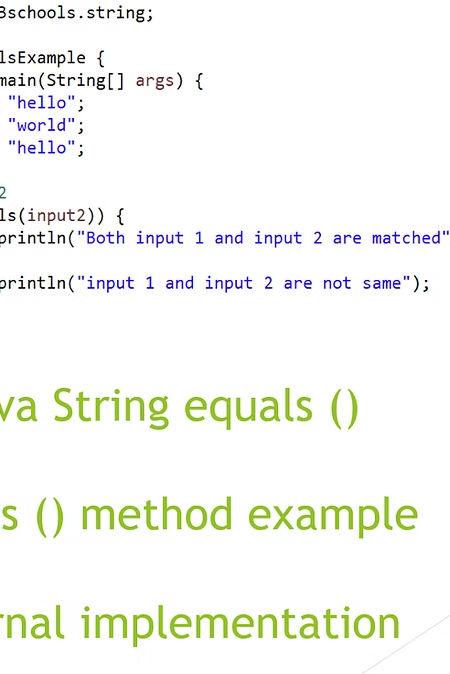

Java equals() Method
The equals() method in Java is used to compare the content of two objects for equality. It is an important method in object-oriented programming, as it allows you to determine if two objects have the same underlying value, rather than just checking if they are the same object in memory. Understand the Java Equals Method and its role in comparing object equality in Java programming. Learn how to effectively use equals for precise comparisons between Java objects.


Understanding the equals() Method
1 Comparing Object Content
The equals() method compares the internal state of two objects, not just their memory addresses.
2 Defining Equality
Developers can customize the equals() method to define what it means for two objects to be considered equal.
3 Consistency
The equals() method should consistently return the same result when comparing the same objects.

Implementing the equals() Method
Checking Object Type
The first step is to ensure the objects being compared are of the same type.
Comparing Attributes
Compare the relevant attributes of the objects to determine if they are equal.
Handling Null Values
Implement logic to handle the case where one or both objects being compared are null.

Overriding the equals() Method
1
Identify Relevant Attributes
Determine which attributes of the object are relevant for defining equality.
2 Implement Equality Logic
Write the custom logic to compare the relevant attributes and return a boolean indicating equality.
3 Consider Performance
Ensure the equality check is efficient and does not negatively impact the overall performance of the application.


Comparing Objects Using equals()
Reflexivity
x.equals(x) should always return true, except for null.
Symmetry
x.equals(y) should return the same result as y.equals(x).
Transitivity
If x.equals(y) and y.equals(z), then x.equals(z) should also be true.
Consistency
Repeated calls to x.equals(y) should return the same result, as long as the objects' internal state remains unchanged.

Equals() in Collections
Set
Ensures unique elements based on equals() method.
Map Requires correct equals() implementation for key comparison.
HashCode
equals() and hashCode() must be consistent for collection usage.


Common Mistakes with equals()
1
2
3
Forgetting to Handle Null
Failing to check for null values can lead to unexpected behavior.
Incorrect Attribute Comparison
Comparing the wrong attributes can result in incorrect equality determination.
Inconsistent HashCode
Implementing equals() without a consistent hashCode() can cause issues in collections.

Best Practices for equals()
ReflexivityEnsure x.equals(x) is always true, except for null.
SymmetryImplement equals() so that x.equals(y) returns the same as y.equals(x).
TransitivityIf x.equals(y) and y.equals(z), then x.equals(z) should also be true.
ConsistencyRepeated calls to x.equals(y) should return the same result unless the objects' internal state changes.

